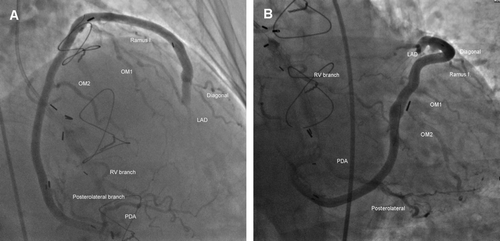Case
A 70-year-old man presented with symptoms of increasing lethargy and reduced exercise tolerance. Sixteen years ago he had undergone coronary artery bypass grafting × 8 with a single multi-sequential saphenous vein ‘snake’ graft to the following vessels (in order of attachment): (1) right ventricular branch of RCA; (2) PDA; (3) posterolateral branch of RCA; (4) second obtuse marginal; (5) first obtuse marginal; (6) ramus intermedius; (7) first diagonal; (8) LAD.
Dobutamine stress echocardiography showed evidence of anterior wall ischemia and he was referred for coronary angiography. In addition to severe occlusive native 3-vessel disease, this revealed a critical stenosis in the proximal segment of the ‘snake’ graft ( A,B). This was directly stented with a 5.0×24 mm Liberte bare metal stent with a satisfactory angiographic result (C) and corresponding improvement in flow through the graft and all distal vessels (annotated in ). As the LAD was the most distal target, in the presence of the stenosis in the graft and multiple proximal anastamoses the flow to this vessel was the most impaired initially and improved substantially following stent placement. Therefore, it is likely that although widespread ischemia was probably present, this was most evident in the anterior wall on stress echocardiography.
Figure 1. Snake graft (lesion arrowed). (A) Pre-PCI—LAO cranial view. (B) Pre-PCI—RAO cranial view. (C) Post-PCI—RAO cranial view.

Figure 2. Snake graft post-PCI images annotated to show all eight target vessels. (A) RAO cranial view. (B) AP caudal view. Owing to the length and size of the graft complete opacification of both the proximal and distal segments could not be achieved simultaneously.

Distal protection was not employed in this case as there was no visible thrombus and the lesion did not appear degenerate. Furthermore, achieving adequate wall apposition of a distal filter device may not have been possible given the large diameter of the graft. The patient had no further symptoms following the procedure and remains well after 6 months.
The average number of anastomoses in previous studies on ‘snake’ grafts is reported to be 3–4 Citation[1]. It is extremely unusual to find as many as eight target vessels supplied by a single graft. Several published studies indicate that patency of a sequential vein graft conduit is generally better than that of an individual one, especially for poor run-off coronary vessels, provided that the most distally located anastomosis is done on a good coronary artery in terms of quality and diameter (as with the LAD in this instance) and may approach that of an internal mammary graft Citation[1–5]. This is illustrated well in the case described here, with a remarkable long-term patency of 16 years for a venous bypass graft.
The likely explanation for this is that the use of side-to-side anastamoses which have a higher patency rate Citation[2], Citation[5] leads to a marked increase in blood flow in the proximal portion of the graft and increases the patency rate of the proximal anastamosis [5]. The use of multiple side-to-side anastamoses also allows for grafting of small coronary arteries (<1.5 mm), which with the conventional single end-to-side anastamosis technique, are not usually bypassed due to the high failure rate and thus more complete myocardial revascularization may be achieved Citation[3], Citation[4]. However, failure of a single sequential conduit jeopardizes all the anastomoses along that graft. One study has shown that in patients with sequential vein grafts only, more myocardial infarctions occurred during 15-year follow up than in patients with single vein grafts only (hazard ratio 2.06, 95% CI: 1.08 to 3.93, P=0.029) Citation[6]. Sequential grafting is also technically more demanding, and the expertise in performing multiple sequential anastomoses is among the important determinants of short- and long-term patency.
Acknowledgements
Declaration of interest: The authors report no conflicts on interest. The authors alone are responsible for the content and writing of the paper.
References
- Quigley RL, Dienhart KJ, Pelkowski DJ, Evans LC, 2nd. Coronary artery bypass with “snake” grafts: fifteen-year follow-up. J Card Surg. 1998; 13: 18–23
- Sewell WH, Sewell KV. Technique for the coronary snake graft operation. Ann Thorac Surg. 1976; 22: 58–65
- Vural KM, Sener E, Tasdemir O. Long-term patency of sequential and individual saphenous vein coronary bypass grafts. Eur J Cardiothorac Surg. 2001; 19: 140–4
- Bigelow JC, Bartley TD, Page US, Krause AH, Jr. Long-term follow-up of sequential aortocoronary venous grafts. Ann Thorac Surg. 1976; 22: 507–14
- Grondin CM, Limet R. 2Sequential anastomoses in coronary artery grafting: technical aspects and early and late angiographic results. Ann Thorac Surg. 1977; 23: 1–8
- van Brussel BL, Plokker HWM, Voors AA, Ernst JMPG, Kelder JC, Knaepen PJ, et al. Different clinical outcome in coronary artery bypass with single and sequential vein grafts: A fifteen-year follow up study. J Thorac Cardiovasc Surg. 1996; 112: 69–78
